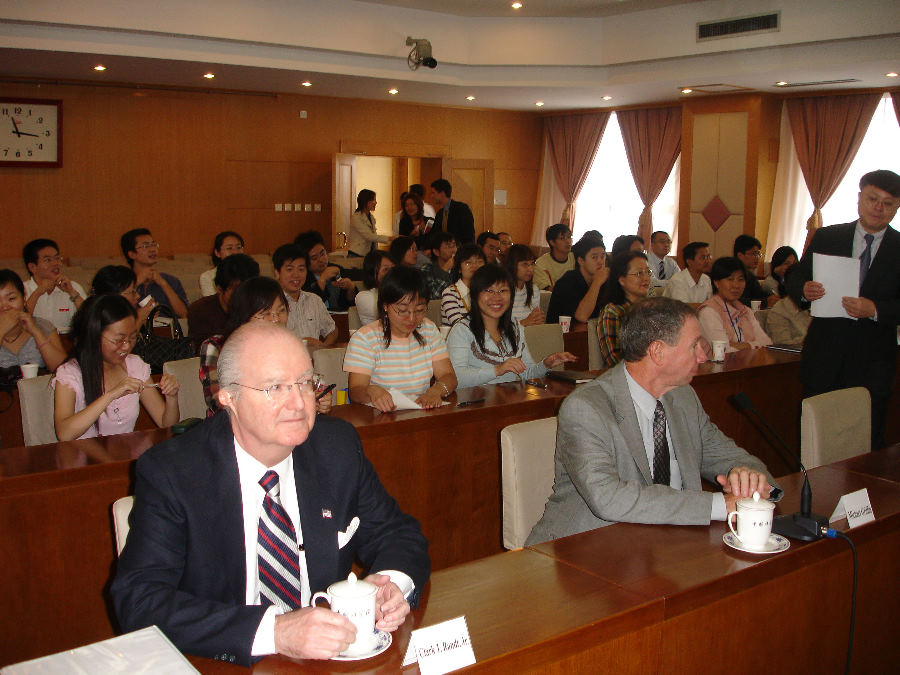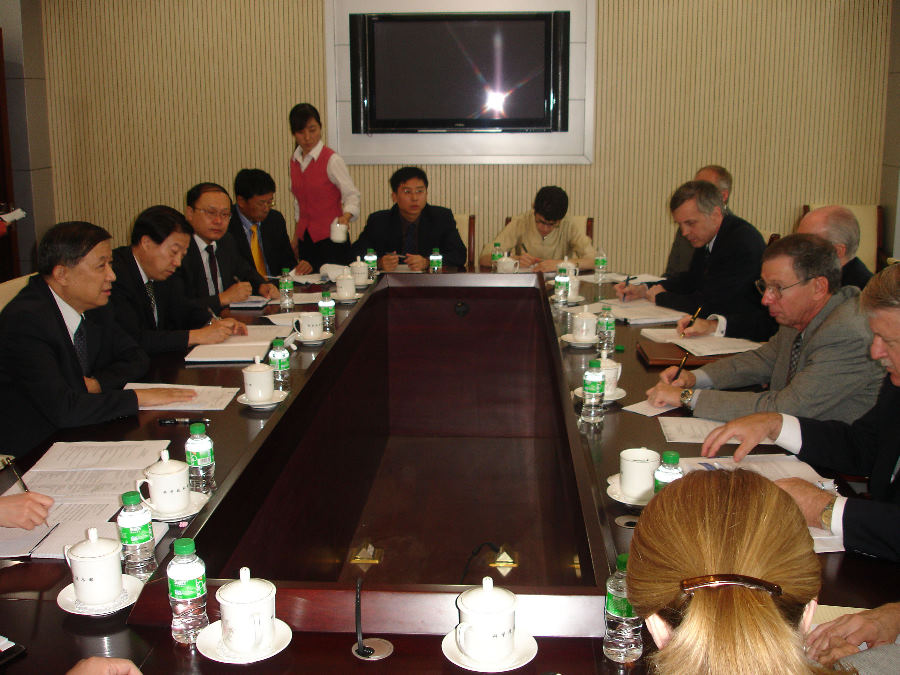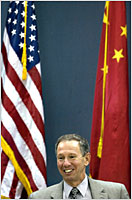|
NASA Dominates World Space Programs |
|||
|
After 'Rewarding' First Visit NASA Administrator Departs China After 'Rewarding'
First Visit
NASA Administrator Michael Griffin returns to the United States today after his landmark visit to China. "I expected to meet capable, involved, committed, energetic people who are devoted to their country's space program," he said of his get-acquainted visit, "and that's exactly what I saw. They've got very obviously expert people doing the work they are doing, fully the equal of any other country doing these sorts of work, certainly nothing other than to be proud of." "One of the points I tried to annunciate over and over again to our meetings with various groups of people was to welcome China to the rank of space-faring nations by virtue of their ability to put people into orbit entirely on their own resources. That is a milestone accomplishment and one to be proud of," he said. Griffin spent his final full day in China in Shanghai, where he had lunch with the city's mayor. He also toured the Chinese Academy of Sciences Shanghai Institute of Technical Physics to review Chinese satellite payload development capabilities. The institute is involved in the development of remote sensing capabilities and Shenzhou spacecraft payloads, as well as infrared detectors and a laser altimeter. "We've had a fairly good discussion of their first lunar-orbiting spacecraft and its mission," he said. "Today we saw an engineering model of the laser altimeter that will go on that mission. That was a very good discussion and very enjoyable." "We saw things at a top level," said Associate Administrator for Space Operations Bill Gerstenmaier, who accompanied Griffin on his trip. "We saw areas that are interesting to us that I think we'll ask our experts at a lower level to pursue and understand in the future. This trip really accomplished what it was supposed to do which was a kind of get-acquainted overview of the China space activity. Next steps will bring in a little more lower level detail in and more specifics about where we're going." Sept. 27 Shanghai Press Briefing (36 Kb PDF)
NASA Administrator Michael Griffin (right) with U.S. Ambassador Clark Randt, Jr., before his talk with graduate students from the Chinese Academy of Science. On his second full day in China, NASA Administrator Michael Griffin spoke to some of the country's brightest future researchers during a speech to graduate students at the Chinese Academy of Sciences. He was accompanied by astronaut Shannon Lucid. Lucid's
China Homecoming
Griffin talked to the students about the evolution of the U.S. space program from one born of competition to one built on cooperation. "The International Space Station set a pattern for cooperative programs to follow," he said. "I believe someday China will be part of that." Image above: NASA Administrator Michael Griffin (right) with U.S. Ambassador Clark Randt, Jr., before his talk with graduate students from the Chinese Academy of Science. Click to Enlarge Credit: NASA. Lucid, who performed extensive scientific research on the space shuttle and on Mir, noted that the students in attendance might someday be given an opportunity to design experiments for China's own human space flight program. With that in mind, she offered three tips for designing research programs in space. She told them to remember that what can be accomplished in a short flight, like a space shuttle mission, is different than what can be accomplished on a long duration flight on a space station. She reminded them to make sure they understood their environment, designing experiments not only for microgravity conditions but ones that also took into account increased radiation and other factors. Finally, she encouraged students to utilize astronaut crew members to enhance the outcome of their experiments. Also Monday, Griffin and his delegation met with China's Minister of Science and Technology, Xu Guanhua, and toured the National Satellite Meterological Center. Griffin told a gathering of news media later in the day that he enjoyed learning about the more "geeky" aspects of the Chinese space program. NASA Administrator Michael Griffin begins discussions with Chinese Minister of Science and Technology, Xu Guanhua.
"We have seen some very nice things," he said. "We saw a very nice algorithm by which Chinese weather satellite developers correct for the apparent motion of the Earth as a result of minor shifts in the orbit of geostationary spacecraft." He also talked to reporters about the value of international cooperation in space. "The problems of space flight are difficult, right at the edge of what's technically possible," he said. "One of the things we derive from international cooperative activities is seeing how different nations and different cultures solve these problems. We learn things; they learn things." "This IS rocket science," he joked.
At Beijing's historic Diaoyutai State Guest House, which dates back 800 years and has played host to hundreds of government leaders, NASA Administrator Michael Griffin met his counterpart Sun Laiyan of the China National Space Administration. The meeting Sunday marked the first visit of a NASA administrator to China. Administrator Griffin presents a picture montage with a flown American and Chinese flags to President and CEO, China Academy of Space Technology, Dr. Yuan Jiajun.
Griffin, an engineer by trade with 35 years of aerospace experience, also got a first hand look at some key technical facilities. He visited one of the major development and production facilities for the Chinese space program, the Chinese Academy of Space Technology (CAST), as well as a payload development center, the Center for Space Science and Applied Research (CCSAR) of the Chinese Academy of Sciences. In his discussions with Sun, Griffin noted his interest in learning more about the Chinese space program. "One of the most important aspects of our trip," Griffin said, "is the opportunity to gain better transparency and trust." U.S. Ambassador to China Clark Randt, Jr., joined Griffin on his first day of tours in China. Randt, who is the longest-serving U.S. ambassador to China, is also an honorary member of the NASA family. His father, Dr. Clark Randt, Sr., served as NASA's first director of Life Sciences from 1959-1961.
NASA Administrator Michael Griffin begins a trip to China this weekend, marking the first time a NASA administrator visits the country. Griffin is making this visit at the invitation of Laiyan Sun, administrator of the China National Space Administration. His visit runs from Saturday to Thursday and includes stops in Beijing and Shanghai. During his trip, Griffin will tour a number of aerospace facilities. "My goal is to become acquainted with my counterparts in China and to understand their goals for space exploration," Griffin said. Senior NASA officials accompanying Griffin to China include Associate Administrator for Space Operations William Gerstenmaier, Assistant Administrator for External Relations Michael O'Brien and NASA astronaut Shannon Lucid, all of whom have extensive experience working with other nations' space programs. Adminstrator Griffin's Itinerary Tuesday, September 26
Wednesday, September 27
Thursday, September 28
|
|||
|
NASA Administrator Welcomes China to Ranks of Spacefaring Nations ..
China, September 25, 2006. (©AP Images) NASA Administrator Welcomes China to Ranks of Spacefaring Nations Griffin’s trip included stops in Beijing, Shanghai, visits to aerospace facilities By Cheryl Pellerin
Washington -- NASA Administrator Michael Griffin returned to the United States September 28 after a landmark visit to China – the first time a NASA administrator has visited that country – to explore and expand space-program cooperation. Griffin made the trip at the invitation of Laiyan Sun, administrator of the China National Space Administration, after discussions between Chinese President Hu Jintao and U.S. President Bush during the U.S.-China summit in April. "One of the points I tried to annunciate over and over again to our meetings with various groups of people,” Griffin said in a September 28 statement, “was to welcome China to the rank of spacefaring nations by virtue of their ability to put people into orbit entirely on their own resources. That is a milestone accomplishment and one to be proud of.” Accompanying Griffin were Associate Administrator for Space Operations William Gerstenmaier, Assistant Administrator for External Relations Michael O'Brien and NASA astronaut Shannon Lucid. Griffin spent his final full day in China in Shanghai, where he had lunch with the city's mayor. He also toured the Shanghai Institute of Technical Physics, Chinese Academy of Sciences to review Chinese satellite payload development capabilities. The institute is involved in the development of remote sensing capabilities, Shenzhou spacecraft payloads, infrared detectors and a laser altimeter. “This trip really accomplished what it was supposed to do,” Gerstenmaier said, “which was a kind of get-acquainted overview of the China space activity. Next steps will bring in a little more lower level detail in and more specifics about where we're going." TOURING THE COUNTRY On September 25, his second full day in China, Griffin spoke to some of the country's brightest future researchers during a speech to graduate students at the Chinese Academy of Sciences. Lucid accompanied him. Griffin talked about the evolution of the U.S. space program, from one born of competition to one built on cooperation. "The International Space Station set a pattern for cooperative programs to follow," he said. "I believe someday China will be part of that." Lucid, who performed scientific research on the space shuttle and on the Russian space station Mir, said the students in attendance someday might have a chance to design experiments for China's own human space flight program and offered tips for designing research programs in space. On the same day, Griffin and his delegation met with Chinese Minister of Science and Technology Xu Guanhua and toured the National Satellite Meteorological Center. Griffin told a gathering of news media later in the day that he enjoyed learning about the more "geeky," or technical, aspects of the Chinese space program. "We have seen some very nice things," he said. "We saw a very nice algorithm by which Chinese weather satellite developers correct for the apparent motion of the Earth as a result of minor shifts in the orbit of geostationary spacecraft." He also talked to reporters about the value of international cooperation in space. "The problems of space flight are difficult, right at the edge of what's technically possible," he said. "One of the things we derive from international cooperative activities is seeing how different nations and different cultures solve these problems. We learn things; they learn things." Griffin, an engineer with 35 years of aerospace experience, also got a firsthand look at some key technical facilities. He visited a major development and production facility for the Chinese space program, the Chinese Academy of Space Technology, and a payload development center, the Center for Space Science and Applied Research of the Chinese Academy of Sciences. U.S. Ambassador to China Clark Randt Jr., joined Griffin on his first day of tours in China. Randt, the longest-serving U.S. ambassador to China, is also an honorary member of the NASA family. His father, Clark Randt Sr., was NASA's first director of life sciences, serving from 1959 to 1961. NASA AND CNSA During a September 25 press conference in Beijing, Griffin said NASA and the China National Space Administration plan to hold dialogues at least once a year. The two space agencies, he added, also might set up working groups in areas such as earth science, climate research, data sharing on various scientific missions, and robotic exploration. NASA has no plans to work with China on International Space Station construction, Griffin said, because "the partnerships [with Russia] that led to the development of the ISS are well established." China and the United States might cooperate on manned space flight some day, but such projects are lower priorities than the International Space Station, Griffin said. The United States is interested in working more closely with China, he added, but the United States is greatly concerned about control over missile technology and nonproliferation. NASA, Griffin said, is “still unable to cooperate with the military-based space program, but we have had a very enjoyable visit with the civilian side of China’s space efforts.” U.S. Ambassador Randt, who participated in the press conference, responded to a question regarding visas for Chinese scientists who want to attend conferences in the United States. He said applicants should allot at least 25 days to get a visa due to enhanced security requirements for people in certain fields. He said 99 percent of applicants receive visas. “This year,” Randt said, “we will issue a record number of visas to Chinese citizens to visit the U.S. Over 300,000 will visit the United States this year, including, we hope, some scientists and engineers.” A transcript (PDF, 25 pages) of the NASA press conference on the China trip is available on the NASA Web site, as is the full text of a related press release. |
|||
| FAIR USE NOTICE: This page contains copyrighted material the use of which has not been specifically authorized by the copyright owner. Pegasus Research Consortium distributes this material without profit to those who have expressed a prior interest in receiving the included information for research and educational purposes. We believe this constitutes a fair use of any such copyrighted material as provided for in 17 U.S.C § 107. If you wish to use copyrighted material from this site for purposes of your own that go beyond fair use, you must obtain permission from the copyright owner. | |||
|
|




